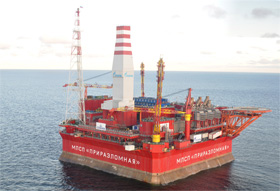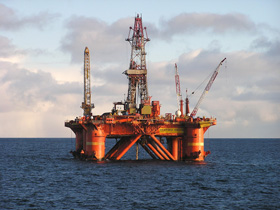The exploration of oil and gas resources in the Russian Arctic is one of the key strategic priorities for the development of domestic fuel and power industry. The available estimates show that the Russian sector of the Arctic shelf may contain about 51 billion tons of oil and 81 trillion cubic meters of natural gas. These reserves are sufficient to maintain the 2011 level of oil production during a century and the relevant volume of gas extraction during hundred and twenty years. At the same time the scale of problems surrounding the exploration of this natural wealth rules out the simplest solutions ensuring fast pay-offs.
The exploration of oil and gas resources in the Russian Arctic is one of the key strategic priorities for the development of domestic fuel and power industry. The available estimates show that the Russian sector of the Arctic shelf may contain about 51 billion tons of oil and 81 trillion cubic meters of natural gas. These reserves are sufficient to maintain the 2011 level of oil production during a century and the relevant volume of gas extraction during hundred and twenty years. At the same time the scale of problems surrounding the exploration of this natural wealth rules out the simplest solutions ensuring fast pay-offs.
The Russian Arctic: challenges of oil and gas exploration
The critical obstacle in the exploration of the Arctic hydrocarbons is the technical complexity of their extraction. Oil and gas resources in the Russian Arctic shelf are concentrated in regions with severe ice conditions (maximum thickness of a one-year ice-sheet is 1.5-2.0 meters) and sea depth of 50-150 meters except for the southern part of the Barents Sea (the Pechora Sea).
Currently, for 90% of O&G areas in the Arctic shelf there exist no suitable exploration technologies or procedures for the mitigation of environmental damage in case of oil and gas leaks. In comparison with similar accidents in the on-shore transpolar fields, e.g. the accident in the Trebs field in the Nenets Autonomous District on April 20, 2012, spills on the offshore rigs are by far more difficult to stop and to mitigate.
Another important issue stems from the legal framework regulating offshore production. In accordance with Article 9 of the Federal Law “On subsoil” the resources in the offshore areas of federal significance can be developed only by companies with 50% public capital and more than 5 years of exploration experience in Russian offshore fields. Today these requirements are met only by “Gazprom” and “Rosneft” that already have licenses for 65 offshore plots and plan to be licensed to explore another 42 plots by 2030 [1]. According to the estimates of the Russian Ministry of Natural Resources and Environment regarding the realistic capabilities of these companies, the exploration of Russian shelf deposits may take up to 165 years [2]. The obvious ineffectiveness of this scenario entailed a radical revision in April 2012 of terms and conditions for the offshore projects implementation. The novelties include the changes made into the fiscal regime and the permission for the access of private O&G producing companies to the shelf.
Tax benefits for offshore production
On April 12, 2012 at the meeting with the leaders of oil-and-gas companies Prime-Minister of Russia V.Putin outlined the key features of a new fiscal regime to be applied to the projects of hydrocarbons extraction on the shelf. These proposals shall be enacted already by October 1.
Essentially they stipulate the following:
- All offshore projects are grouped into four categories depending on the degree of difficulty and the applicable tax rates are defined for a relevant category (category 4 has the maximum tax benefits but includes the most difficult to implement projects in the Arctic, including fields in the northern part of the Barents Sea);
- The mineral extraction tax (MET) shall be calculated as a percentage of the sale prices of extracted oil and gas (royalty concept) and shall make 30% for category one projects, 15% - for category two, 10% - for category three and 5% for category four;
- Export duties will be abolished for all categories of the offshore projects;
- Profit tax will remain unchanged, but for some licensed plots calculation formulas for incomes and expenses can be change together with period of tax losses carry forward;
- It is proposed to reduce to zero the property tax and VAT for the imported state-of-the art equipment used in the offshore projects and unavailable in Russia;
- There are provisions for the stability of fiscal legislation, stipulating the obligation of the government to keep the rates of profit tax, MET and export duties unchanged for the period from 5 years (for the first category of projects) up to 15 years (for the fourth category of projects) starting from the beginning of the commercial development, but if the global oil prices go below 60 USD/barrel, tax rates can be reduced.
The government expects these actions to attract about $500 b to the offshore projects over 30 years. At the same time the above mentioned tax benefits are aimed to foster the prospecting and exploration of new fields and should not impact the existing projects. In the Arctic the Prirazlomnoye oilfield in the Pechora Sea with the reserves of 72 mln. tons of oil and the expected output of 6.6 mln.tons per year became “a victim” of this approach. As compensation the government approved on April 25, 2012 a beneficial export duty amounting to 45% of the basic rate for the crude oil export [3]. The license for the exploration of Prirazlomnoye field is held by “Gazprom” daughter company “Gazprom Neft Shelf”. In August 2011 an ice-resistant platform “Prirazlomnaya” was set in the field to drill 40 directional wells. It is expected that the extraction of oil at Prirazlomnoey field will start as early as 2012 (). So it will become the first commercial oil-producing hydrocarbon field in the Arctic shelf.
Corporate alliances – with foreigners and name them…
Another important novelty of 2012 was a decision to allow private companies to participate in offshore projects. In February 2012 this initiative was put forward by Prime-Minister V. Putin. He had to admit that the monopoly of two state giants for the exploration of the Arctic shelf “somehow holds the production development” [4]. The first practical outcome of this initiative was a strategic alliance between “Rosneft” and “ExxonMobil”. As stipulated in the agreements signed in April 2012, “ExxonMobil” through the joint operating companies [5] will gain access to the exploration of three Russian fields in the basins of the Kara Sea (East-Prinovozemelsky-1, 2 and 3) and Tuapse licensed plot in the Black Sea, and “Rosneft” will get 30% in the “ExxonMobil” projects in the Delaware basin of Western Texas (La Escalera site), in Canadian province Alberta (Harmattan site at Cardium formation) and in the western part of the Gulf of Mexico (20 blocks). The initial stage of prospecting on the Russian shelf is estimated in $3.2 b. In 2012 the seismic study and the environmental assessment are planned for the plots in the Kara Sea (with total amount of recoverable reserves of 4.9 bln.tons of oil and 8.3 trn.cub.m of natural gas) and in 2014 – the drilling of exploration wells.
The alliance with “ExxonMobil” should be viewed as a major success of “Rosneft” and the Russian government. First of all it implies the exchange of assets with the foreign oil producing company for the first time after the failure of the deal between “Rosneft” and BP in May 2011 where 5% of BP shares were planned to be exchanged for 9.5% of Rosneft shares (total amount 18 bln.USD) and BP’s access to the exploration of the Russian Arctic shelf. In case of “ExxonMobil” the direct exchange of stock in not discussed but “Rosneft” gets partnership interests in foreign projects that may have a positive impact on the company funds and international image. Secondly, “Rosneft” enters into partnership with one of the global leaders in oil production that means gaining access to the cutting-edge technologies of the offshore fields exploration and potential involvement in the joint development of the relevant know-how [6].
And thirdly, a strategic alliance of “Rosneft” and BP sets an example for the cooperation with other private companies that can get the access to the exploration of offshore fields as junior partners of public companies. Already on April 25 a strategic cooperation agreement was signed by “Rosneft” and Italian company “ENI” for the participation of the latter in the exploration of the offshore fields in the Barents and the Black Seas. Total expected investments into the development of Fedynsky and Central Barents blocks in the Barents Sea are estimated to reach $50-70 b. The seismic study is planned for 2016-2018 and the drilling of exploration wells – for 2025-2026. Prospecting of all offshore plots is financed by “ENI” at the amount of $2 b. In return, “ENI” will provide to “Rosneft” a stake in its foreign projects (to be defined in the coming months) [7].
Similar to the “ExxonMobil” case the attractiveness of this alliance for “ENI” was predetermined by tax benefits for the offshore projects approved by the Russian government. The interest to offshore projects can be expressed by other foreign companies that received relevant proposals from “Rosneft” – such as “Shell”, “Statoil”, “Total”, “Сhevron” and “ConocoPhillips”. For Russian companies – “Lukoil”, “TNK-BP”, “Surgutneftengas” and “Bashneft” who also were invited to participate in the exploration of 12 offshore blocks in the Arctic, the scheme tested in “ExxonMobil” and “ENI” agreements – 33.3% of partnership interest and financing of all prospecting costs and other large expenses of the first stage, may turn less attractive [8]. Russian companies have neither in-house technologies for the offshore production nor the relevant experience and thus can not count on high profitability of exploration. So, additional incentives may be needed to stimulate their participation in the shelf projects.
The Shtokman field: uncertainty persists
The lack of certainty in the exploration of the Shtokman gas deposit located in the central part of the Russian sector of the Barents Sea became the main disappointment of this spring. Reserves of this deposit are evaluated as 3.9 trn.cub.meters of natural gas and 56 mln. tons of gas condensate. “Shtokman Development AG” was created in 2008 for the first stage of the field development. 51% in the company capital is held by “Gazprom”, 25% - by French “Total” and 24% - by Norwegian “Statoil”. After the completion of the first stage the annual production of gas will amount to 23.7 bln.cub.m/year, but when the project reaches the design capacity (71.1 bln.cub.m. annually) – the production capacity of this field will be able to meet the demand of annual gas consumption in Germany.
Foreign partners of “Gazprom” several times stated that in view of difficult environmental conditions and high starting costs the project efficiency can be guaranteed only under significant tax benefits. At the same time Shtokman deposit is already “in the development” stage and can not enjoy the above described tax relief announced in April 2012 and applicable to new offshore projects. The situation, however, has deteriorated in the wake of the recent initiatives of the Russian government on increasing the MET on the natural gas that even more diminishes the expected returns from the project. In this environment all hopes to get tax benefits are connected with the application of “manual regulation”, but it’s being postponed over and over again. Consequently, the final investment decision on the project has also been postponed (last time it was delayed till July 01). It is fraught with further delays of the actual launch and endangers the beginning of gas supplies initially planned for 2016. Regardless of the persisting uncertainty for Shtokman field future, new measures of the Russian government to stimulate the involvement of private companies in the Arctic offshore projects have produced an impressive jumpstart. Further steps towards this direction, including the increase of the private companies’ participation interest and an optimal ratio between private and public funding of the launch costs in complex projects may give an additional impetus to the accelerated practical exploration of hydrocarbons on the Russian Arctic shelf.
1. Kommersant, 17.04.2012.
2. IA “Novy Region”, 31.03.2010.
3. RosBisnessConsulting, 25.04.2012.
4. RosBisnessConsulting, 29.02.2012.
5. A share of “ExxonMobil” in the capital of these companies shall make 33.3 %. The principle decision to create them was taken already in August 2011 when a fundamental agreement to set a strategic alliance between “Rosneft” and “ExxonMobil” was reached.
6. It is symptomatic that in parallel to the signing of cooperation agreements between “Rosneft” and “ExxonMobil” for shelf exploration an agreement for the joint development of extraction technologies for problematic resources in Western Siberia was also signed. It might be expected that similar agreement on the development of offshore technologies shall be executed.
7. Quote.ru, 25.04.2012.
8. Kommersant, 17.04.2012.






